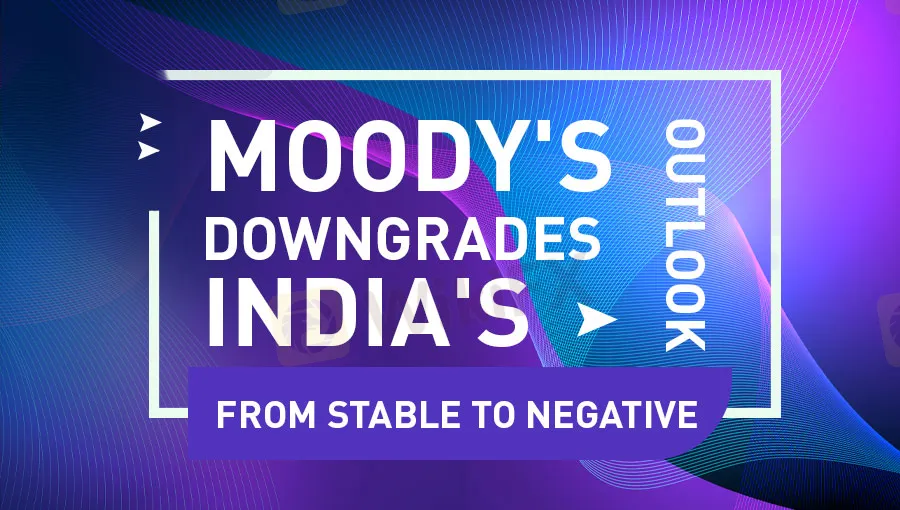简体中文
繁體中文
English
Pусский
日本語
ภาษาไทย
Tiếng Việt
Bahasa Indonesia
Español
हिन्दी
Filippiiniläinen
Français
Deutsch
Português
Türkçe
한국어
العربية
Moody’s Downgrades India’s Outlook from Stable to Negative
Ikhtisar:Moody's Investors Service downgraded its outlook on India's ratings from “stable” to “negative”, citing rising risks to India's economic growth. Tumbling down to its lowest level in three weeks, the rupee fell as much as 0.5% against the US dollar to 71.31 at one point, the first decline in three weeks; the Indian stock market also dropped as the NSE index fell 0.4%.

Moody's Investors Service downgraded its outlook on India's ratings from “stable” to “negative”, citing rising risks to India's economic growth. Tumbling down to its lowest level in three weeks, the rupee fell as much as 0.5% against the US dollar to 71.31 at one point, the first decline in three weeks; the Indian stock market also dropped as the NSE index fell 0.4%. India‘s economic growth will still be significantly lower than in the past, which reflects to a certain extent that the government’s policy in addressing long-standing economic and institutional weaknesses is less effective than expected, and the situation can lead to a gradual rise in the already high level of debt burden.
In the first quarter of the fiscal year starting from April 1st, India's economic growth rate fell back to its lowest level in six years, as debt issues of banks curbed corporate and consumer spending in Asia's third-largest economy. In the three months ended June 30th, India's gross domestic product (GDP) growth fell to 5.0%. The data suggests that as the global economy shows a warning sign of a slowdown, India, which serves as a major engine for global economy, is also weakening.
Moody's observed that “Although the governments support for the economy should help reduce the depth and duration of India's slowdown, the ongoing financial pressure among rural households, weak employment creation, and recent credit crunch in non-bank financial institutions have all increased possibility of a more entrenched slowdown in the Indian economy.” The rating agency said that unless reforms are introduced to directly reduce barriers on labor and land productivity, stimulate private sector investment and continue to strengthen the financial sector, potential GDP growth and job creation opportunities will still be restricted.
“Without such reforms, structural constraints on productivity and job creation will weigh further on Indias sovereign credit profile.” Moody's confirmed India's Baa2 foreign currency and local currency long-term issuer rating, and confirmed India's Baa2 local currency priority unsecured rating. In Moody's rating system, Baa2 is a mediocre rating, indicating a moderate credit risk.

Disclaimer:
Pandangan dalam artikel ini hanya mewakili pandangan pribadi penulis dan bukan merupakan saran investasi untuk platform ini. Platform ini tidak menjamin keakuratan, kelengkapan dan ketepatan waktu informasi artikel, juga tidak bertanggung jawab atas kerugian yang disebabkan oleh penggunaan atau kepercayaan informasi artikel.
Baca lebih banyak

Join and GET 2100 WikiBit for free on Christmas Day!
Countdown 24 hours!

Data Ekonomi Menjadi Aneh? Bagian II
Masalah serupa berlaku untuk "survei pendirian," yang B.L.S. gunakan untuk mentabulasi angka pertumbuhan pekerjaan. Agensi mensurvei sekitar 145.000 bisnis dan agensi pemerintah tentang berapa banyak karyawan yang mereka miliki dalam daftar gaji.

Data Ekonomi Menjadi Aneh? Bagian I
Amerika Serikat mengalami keruntuhan yang tak terduga dalam aktivitas ekonominya. Itu yang kita tahu. Tetapi lebih dari itu bahkan dalam resesi normal, alat-alat yang harus kita pahami apa yang terjadi pada perekonomian menjadi terdistorsi atau lebih sulit untuk ditafsirkan, karena berbagai alasan.

Corona Menyentuh Ekspor, Perdagangan Jepang Turun 99% Pada Maret
Surplus perdagangan Jepang turun 99 persen di bulan Maret dari tahun sebelumnya karena masalah virus corona memukul ekspor ke mitra dagang utamanya, data resmi menunjukkan Senin.
WikiFX Broker
WikiFX Broker
Berita Terhangat
Seri Ulasan Broker WikiFX: GTCFX Anggota Terbaru The Financial Commission
Kripto Ekspansi Ke CFD? Coinbase Akuisisi Broker Forex BUX Europe Limited
AWAS ! Beberapa WNI Jadi Korban Platform Trading Broker Forex FxPro
Tantang Diri Anda ! Perjalanan Kemajuan Bertransformasi dari Pemula menjadi Ahli Forex
Nilai Tukar






